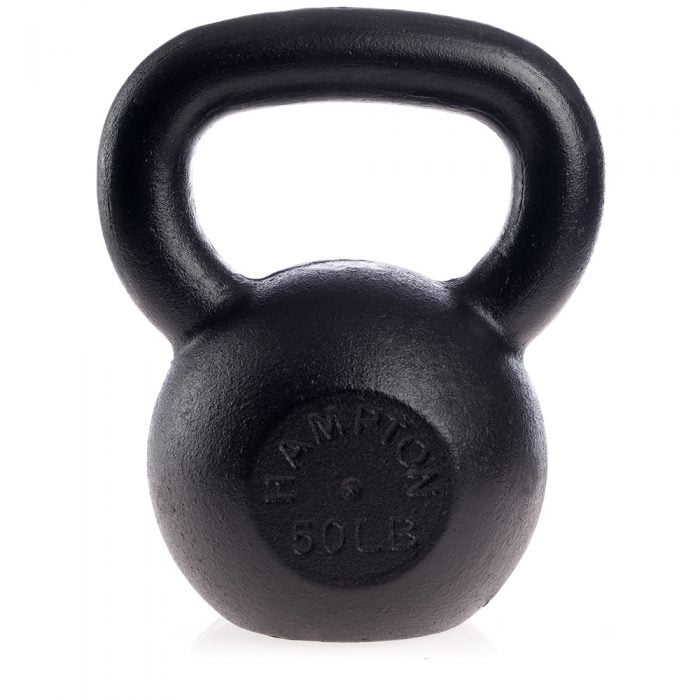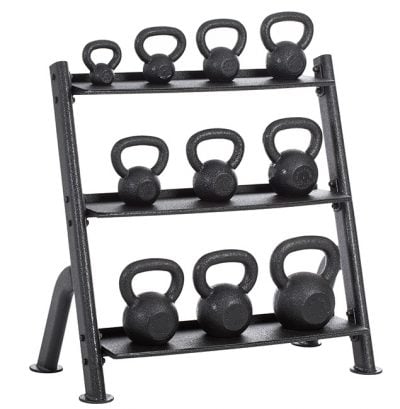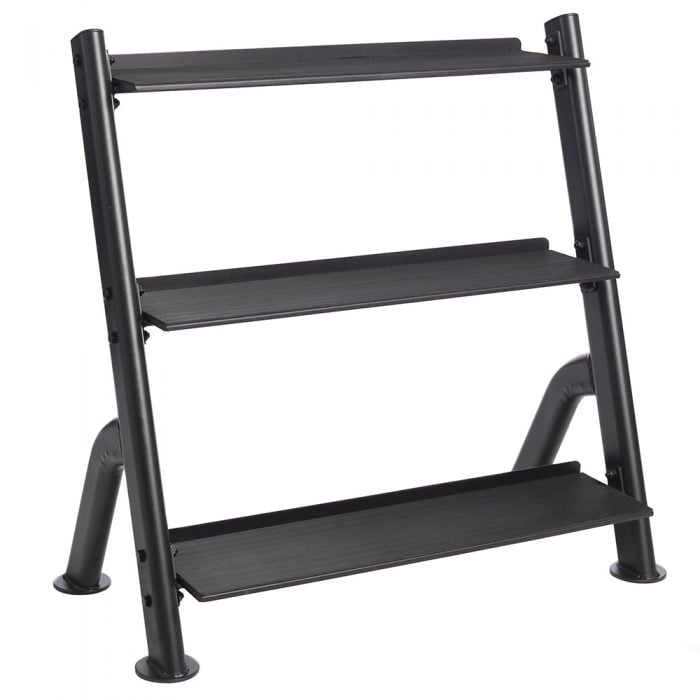So you want to get into kettlebell training, or maybe you’ve been in for a while and are looking to up your game. You’re wondering how many kettlebells are really necessary for maximizing your workout and how many are just wasted money. You’ve come to the right place! In this article, we’re covering how to determine the right number of kettlebells for you.
Key Takeaways
- The number of kettlebells you need for optimal training depends on your fitness level and goals.
- If you’re a beginner, one kettlebell should be adequate. Once you’re comfortable with it, you can add a second.
- While buying kettlebell pairs can be tempting, only do so if it fits your workout style. Otherwise, it’s best to invest in several kettlebells of varying sizes.
Understanding How Many Kettlebells Do I Need?
When you’re new to kettlebell training, it’s natural to ask, “How many kettlebells do I need?” The answer varies based on your fitness goals, current strength levels, and the types of exercises you plan to perform. If you’re just starting, you might wonder how many kettlebells you’ll use. For beginners, one kettlebell may work for a while. This single kettlebell lets you master basic moves like swings, squats, and presses.
However, as you progress, you’ll likely notice that one kettlebell just isn’t cutting it anymore. But do you need multiple kettlebells to keep your routine at peak effectiveness? Adding a second kettlebell enhances your ability to do advanced exercises and engage in bilateral movements, which can promote symmetrical strength and balance.
Additionally, the weight of the kettlebell you choose is crucial. Many fitness enthusiasts find that having kettlebells in various weights ensures they’re challenging their muscles and avoiding plateaus. So, consider your evolving workout needs and goals when considering how many kettlebells to purchase. Balancing the number of kettlebells you use with your workout requirements can significantly enhance your training success. The best way to determine how many you’ll need is to assess your fitness level and where you want your training to take you.
Starting with One Kettlebell
When you’re just beginning your kettlebell journey, it’s easy to think you need a whole collection of kettlebells. However, you only need one to get started. One kettlebell of moderate weight is sufficient for various foundational exercises.
Starting with one kettlebell lets you focus on mastering the basics, ensuring you develop proper form and technique. One kettlebell is enough for most beginners to perform movements like swings, goblet squats, and Turkish get-ups.
This approach makes your training more focused and budget-friendly. Remember, the quality of your kettlebell training isn’t determined by the number of kettlebells you have but by how effectively you use them. By starting with one kettlebell, you build a strong foundation and can later unlock the potential of using two kettlebells. This gradual progression ensures long-term success and safe, practical training.
Investing in one or two kettlebells allows you to reap the benefits of kettlebell training without the clutter. As you progress and grow stronger, consider adding one or two kettlebells of different sizes to your collection.
Unlocking the Power of Two Kettlebells
When you’re looking to maximize the advantages of kettlebell workouts, it’s a great idea to use at least two different sizes of kettlebells. This is especially true for those transitioning from single kettlebell training to more advanced routines.
Having two different kettlebells can tailor your exercises to target various muscle groups more effectively. So, how many kettlebells do you need for an effective workout? As you level up in your skills and train harder, the answer might quickly become two kettlebells.
Kettlebell exercises with two kettlebells allow for improved balance, coordination, and strength development. Additionally, it opens up a new range of exercises that aren’t possible with just one kettlebell. Having a set of kettlebells ensures you can progress through different weights as you build strength and endurance. For example, you might start with a lighter kettlebell for high-repetition sets while using a heavier one for strength training.
This versatility answers the common question, “Do I need multiple kettlebells?” effectively. Having at least two different sizes of kettlebells can revolutionize your fitness regimen, offering both variety and a structured path for progression, ensuring that you get the most out of your kettlebell workouts.
Recommended products
-
Hampton Kettlebell – Black Powder Coated
$12.00 – $246.00 -
Outdoor Urethane Coated Kettlebell Packs
$1,539.00 – $3,195.00 -
3-Tier Horizontal Kettlebell Rack
$469.00
Single vs. Double Kettlebell Training
Both single and double kettlebell training have significant benefits. However, one might be better for you based on your fitness journey. Below, we break down the advantages of each.
Advantages of Single Kettlebell Training
First and foremost, you’ll only need to focus on managing one weight, which simplifies learning proper form and execution. Single kettlebell workouts provide a comprehensive full-body workout that enhances strength, endurance, and mobility.
Additionally, training with a single kettlebell makes transitioning into more advanced movements easier without overwhelming yourself. Single kettlebell training also offers flexibility regarding workout variety, allowing you to effectively tailor your sessions to target different muscle groups. Investing in one kettlebell initially means you’ll save on costs, making it a budget-friendly option for those new to kettlebell training. Whether you’re working out at home or the gym, a single kettlebell is easy to store and transport.
Advantages of Double Kettlebell Training
Double kettlebell training offers numerous advantages for those looking to escalate their workouts. When you incorporate two kettlebells into your training, you can perform more complex movements that significantly enhance strength and stability. Utilizing double kettlebells allows for symmetrical loading, which ensures both sides of your body are equally engaged, preventing muscular imbalances. This type of training intensifies the workout experience, leading to increased heart rate and improved cardiovascular health.
With double kettlebells, you can execute lifting techniques like the double clean, double kettlebell front squat, and double snatch, which are excellent for building muscle mass and power. These exercises demand simultaneous coordination and control, fostering greater neuromuscular efficiency. Additionally, double kettlebell workouts provide a more challenging core workout because they require more stability and balance, making your core work extra hard to maintain proper form.
Double kettlebell training is a transformative choice if you aim to take your workouts to the next level. Incorporating it into your regimen means achieving aesthetic goals and gaining functional strength that helps you with everyday activities. From amplifying metabolic burn to enhancing full-body conditioning, double kettlebell workouts’ advantages make them indispensable to advanced training routines.
Progression from One to Two Kettlebells
Don’t be afraid to take it slow when you’re transitioning to two kettlebells. You may need to start with lighter weights than you’re used to, and be sure to stop if you’re feeling overly tired. Kettlebells are incredible fitness aids, but they can be dangerous if you’re slinging around two heavy weights while feeling exhausted!
Once you feel confident with two kettlebells, you can slowly incorporate heavier weights and more complex moves. Take it slow, and you’ll be a two-kettlebell pro in no time!
Do I Need Two Kettlebells of the Same Weight?
When it comes to kettlebell training, it’s common to ask whether you need two kettlebells of the same weight. The short answer is that it depends on your workout goals and current fitness level. Having two kettlebells of the same weight can be particularly useful for exercises that require bilateral training, such as double kettlebell swings, double front squats, and double kettlebell presses. These exercises help improve overall strength and symmetry, enhancing your workout effectiveness.
However, not every workout should focus on using two kettlebells of the same weight. Some exercises, like kettlebell snatches and one-arm kettlebell swings, only require a single kettlebell. Additionally, owning kettlebells of varying weights allows you to progress more efficiently. For example, as you get stronger, you can gradually move up in weight, rather than having to purchase a new set every time.
Ultimately, whether you should get two kettlebells of the same weight depends on your specific fitness goals and workout routines. If you’re focusing on symmetry and double kettlebell exercises, having a matching set of weights may be beneficial. Otherwise, starting with one kettlebell and gradually building your collection with different weights, as needed, can offer a more balanced and versatile approach to your training regimen.
Selecting the Right Kettlebell Weight for Training
Selecting the right kettlebell weight for your training ensures effective workouts and prevents injury. The appropriate kettlebell weight can vary depending on your fitness level, the types of exercises you’ll be performing, and your training goals.
- Strength Training: As endurance builds, a range of kettlebells is required. Strength training often requires progressively heavier weights as you advance. Various weights call for performing different exercises at optimal resistance levels. Presses and snatches may require lighter weights than squats and deadlifts.
- Endurance Training: Lighter kettlebells benefit endurance workouts, which involve higher repetitions. Endurance exercises typically use lower weights to enable sustained activity for longer periods of time.
- Functional and Circuit Training: These training styles benefit from having multiple kettlebells in different sizes. Circuit training involves moving quickly between different exercises, requiring kettlebells of varying rates to match the specific demands of the movements. It is also important for gym owners with many people in and out of their circuit classes.
If you’re uncertain which kettlebell weight to choose, consult a certified trainer for personalized recommendations. Effective training with the right kettlebell weight will lead to safe and productive workouts.
Balancing Budget and Kettlebell Benefits
When considering how many kettlebells you need, balancing budget and kettlebell benefits is crucial. If you’re on a budget, it’s essential to prioritize the kettlebells you need most for your workouts. Selecting versatile kettlebells can maximize the benefits of your training without overwhelming your finances. You’ll want to invest in weights that support your strength goals and training style.
A key factor to consider when balancing your budget and kettlebell needs is the kettlebell’s material. Cast iron is the traditional material, but it’s more expensive. Because cast iron is less dense than steel, cast iron kettlebells tend to be larger for lighter weights. On the other hand, steel kettlebells are becoming more common because they are more durable, can be made in a consistent size regardless of weight, and are generally cheaper than cast iron kettlebells.
Coating is also an important factor. Below is a rundown of the types of coating you might see:
- Paint/Enamel: This inexpensive option is prone to chipping and scratching. It offers minimal protection for the kettlebell or your floor.
- Powder Coat: More durable than paint, offers better scratch and chip resistance. It can be slightly textured for grip, but it is not ideal for protecting floors.
- Vinyl/Neoprene: This option protects the kettlebell and your floor from scratches, but the coating can be slippery when wet with sweat. It is also not the most durable option.
- Urethane: The most well-rounded coating. It’s highly durable, protecting the kettlebell from chips, scratches, and wear and tear. It also protects your floor from scratches and dings. Urethane is weather-resistant, making it suitable for outdoor use, and some users find it offers a good grip.
Urethane offers the best overall protection and versatility, but it comes at a premium. If you prioritize durability, use your kettlebell on various surfaces (including outdoors), and don’t mind spending more, urethane is a great choice. However, if you’re on a tight budget and primarily use your kettlebell indoors on a gym floor, a powder-coated kettlebell might be a sufficient and more affordable option.
Should you buy kettlebells in pairs?
When deciding whether you should buy kettlebells in pairs, it’s essential to consider your fitness goals and budget. Some exercises only require one kettlebell, so you might start there. However, having pairs can be better if you want to perform more advanced movements, like double kettlebell cleans, presses, and squats. Owning pairs allows you to balance your workouts and challenge your body symmetrically, which can be a significant advantage.
On the cost side, buying pairs can be more expensive initially, but it might save you money in the long run because you’re less likely to need additional equipment. Still, should you get kettlebells of the same weight in pairs? It depends. Some exercises necessitate the same weight for balance. But, for varied workouts, having different weights can be beneficial, offering versatility within your training regimen.
Can kettlebell training help you get ripped?
Wondering if kettlebell training can help you get ripped? The answer is a resounding yes! Kettlebells are versatile and practical tools for workouts that target multiple muscle groups simultaneously. Unlike traditional weight training, kettlebell exercises incorporate strength and cardiovascular elements, leading to efficient calorie burning and muscle building.
When you’re using a kettlebell for your workout, you’re not just lifting weight but also improving your coordination, flexibility, and balance. This one piece of equipment can transform your training routine, making it easier to achieve a ripped physique. So, if you aim to get ripped, incorporating kettlebell workouts into your routine is smart.
Frequently Asked Questions (FAQ)
Do you still have questions? Below are a few more common queries you may have as you progress on your kettlebell journey.
“How many kettlebells do I need?”
The answer varies based on your fitness goals and workout routines. Typically, beginners should start with one kettlebell, mastering fundamental moves before transitioning to double kettlebell training.
“What size kettlebell should I start with?”
A good rule of thumb is to choose a weight that challenges you without compromising your form. As you advance, you might find you need to invest in kettlebells of different weights to match different exercises.
“Do I need two kettlebells of the same weight?”
Having two kettlebells of the same weight is ideal for exercises that involve symmetry, like dual swings or double cleans. However, different weights can be useful for staggered exercises.
Conclusion
Ultimately, the size, type, budget, and number of kettlebells you need will evolve with your fitness journey, so consider starting small and gradually expanding your collection as you gain experience and strength. Happy training!





